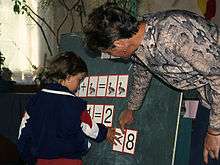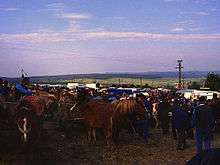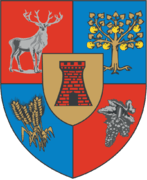Hodod
| Hodod Hadad, Kriegsdorf | |
|---|---|
| Commune | |
 Hodod | |
| Coordinates: 47°24′N 23°2′E / 47.400°N 23.033°E | |
| Country |
|
| County | Satu Mare County |
| Population (2002)[1] | 3,199 |
| Time zone | UTC+2 (EET) |
| • Summer (DST) | UTC+3 (EEST) |






Hodod (Hungarian: Hadad, Hungarian pronunciation: [hɒdɒd]; German: Kriegsdorf) is a commune of 3,209 inhabitants situated in Satu Mare County, Romania. It is composed of four villages:
| Romanian[2] | Hungarian[2] | German[2] |
|---|---|---|
| Giurtelecu Hododului | Hadadgyőrtelek | Wüst Jörgen, Georgius |
| Hodod | Hadad | Kriegsdorf |
| Lelei | Lele | Lellen |
| Nadișu Hododului | Hadadnádasd | Ungarisch Rohrdorf, Rohrfeld |
Geography
The municipality of Hodod lies in the extreme southeast of the county Satu Mare and borders in the west to the municipality Bogdand, in the north to the Maramures county and in the east and south by the Sălaj county. The municipality is located in the hills of Codru, 10 km west of Cehu Silvaniei and 70 km south of Satu Mare, the capital of the Satu Mare county.
History
Until 1940
Hodod is mentioned since 1210, Nadișu Hododului since 1205, Lelei since 1330, Giurtelecu Hododului since 1378. Hodod belonged to the Kingdom of Hungary and was part of the Principality of Transylvania. In 1399, a castle is mentioned when the village belonged to the family Kusalyi Jakcs. Hodod gained city status in 1482.
Hodod was given by King Rudolf II of Habsburg to the Wesselényi family, to whom it belonged until the 20th century. The castle was destroyed in the early 18th century. After the rebellion of Francis II Rákóczi, the town was taken from the Wesselényi family.
The Wesselényi family built a large castle in Baroque style. After the outbreak of the plague, the immigration of German settlers was promoted. From 1744 to 1751 Baron Franz Wesseleny invited 30 families from Baden-Durlach and Switzerland to his property in Kriegsdorf (Hadad). In subsequent years, more immigrants came from German-speaking regions to Kriegsdorf.[3][4] In 1880 Kriegsdorf counted 479 German inhabitants.
After the Austro-Hungarian compromise of 1867 the Austrian Empire, and the Principality of Transylvania, disappear. In 1876 the Kingdom of Hungary is divided into provinces. Hodod is now part of Szilágy County. At the end of World War I, the Austro-Hungarian Empire disappears and the city is part of Greater Romania in the Treaty of Trianon. Hodod is now part of the district Sălaj.
1940-1945
Hodod in 1940 following the Second Vienna Award, annexed by Hungary until 1944. In May 1944, the Jews were collected in the ghetto of Satu Mare. On May 19, 22, 26, 29, 30, 31 and June 1 of that year, they were deported to Auschwitz.[5][6][7]
The fate of the Roma is little is known. This is partly due to the fact that the Roma, in comparison with the Jews, were poorly organized.[8][9] With the retreat of the German army in 1944, many Germans left Hodod. In 1945, 43 Germans were deported to the Soviet Union.[10]
After 1945
After the Second World War Hodod, with the Treaty of Paris, became Romanian again. In the administrative reform of the country in 1968, the city became part of the Satu Mare county to which it belongs so far.
During the communist regime, especially in the 1980s, many Germans emigrated.
Demographics
Ethnic groups (2002 census)[11]
- Hungarians: 2166 (67,70%)
- Romanians: 907 (28.35%)
- Romani people: 79 (2.46%)
- Germans: 46 (1.43%)
Inhabitants per village (census 2002)[11]
- Giurtelecu Hododului: 816
- Hodod: 912
- Lelei: 662
- Nadișu Hododului: 809
Religion
In 2002, the religious composition of the municipality is as follows:[11]
- Reformed: 60.26%
- Orthodox: 27.57%
- Baptist: 7.87%
- Pentecostal: 1.71%
- Catholic: 0.84%
- Seventh-day Adventist: 0.56%
Language
The official language is Romanian. In Hodod, Nadișu and Lelei Hungarian is predominantly spoken. Giurtelecu speaks mainly Romanian, while the Roma speak Romani (language of the Roma, gypsies). A small minority speaks German.
Ethnic minority groups (Hungarians, Swabians) often identify first with their ethnicity and second as Romanians. In villages with a predominantly Hungarian population it is polite to use Hungarian place names (Hadad Hadadgyőrtelek, Hadadnádasd, Lele). When speaking to Romanians the use of Romanian place names is polite (Hodod, Lelei, Giurtelecu Hododului, Nadișu Hododului). This applies also to titles such as "mayor" (Hungarian: polgármester; Romanian: Primar).
In terms of foreign languages, a part of the population speaks English, French, and German. Historically, French was the leading language of study, but nowadays English is replacing it, so that the elderly in Romania can speak French and youngsters English.
Politics
The Hodod City Council has 13 Councillors. At the time of the Romanian municipal elections of June 2016,[12] Francisc Balog (UDMR) was elected as Mayor.[13]
| Party | Number of Councillors |
|---|---|
| Democratic Union of Hungarians in Romania Uniunea Democrată Maghiară din România (UDMR) |
9 |
| National Liberal Party Partidul Național Liberal (PNL) |
1 |
| Social Democratic Party Partidul Social Democrat (PSD) |
1 |
| Alliance of Liberals and Democrats Alianța Liberalilor și Democraților (ALDE) |
1 |
| Hungarian Civic Union Partidul Civic Magiar - Magyar Polgári Párt (PCM) |
1 |
Not all parties are nationally operating parties.
Education

Hodod has an elementary school.[16] Nadișu, Giurtelecu and Lelei are dependencies. Romanian children attend elementary education from their 6th until their 14th year.
The Romanian educational system is as follows:
- Scoala Primara şi gimnaziala - elementary school
- Liceu - secondary education
- Invăţământ Superior - high school
Economy

Agriculture
The economy of the municipality is based on agriculture (arable, livestock and beekeeping).
Market
A large market is held in Hodod the first Monday of every month.
Historic sites and monuments

Castles
- Hodod, Wesselényi Castle, one of the landmarks of the Baroque style in the district of Satu-Mare. Eighteenth century.[17]
- Hodod, Degenfeld castle. Eclectic Architecture. Nineteenth century.[17]
Church Buildings
- Hodod, Evangelical Lutheran Church. Eighteenth century.[18][19]
- Hodod, Reformed Church,[20] Gothic architecture. Fifteenth century, classified historic monument.[18]
- Nadișu Hododului, Reformed church,[21] Fifteenth century, classified historic monument.[18]
- Giurtelecu Hododului, Orthodox church.[18]
- Lelei, wooden orthodox church of the Holy Archangels. 1870, classified historic monument.[18]
- Lelei, wooden protestant church,[22] built 1783 - 1788.[18][23]
Cemeteries
East of Hodod, hidden between the fields and groves, there is a Jewish cemetery.[5] Also in Nadișu Hododului[6] and Lelei[7] are Jewish cemeteries. In Hodod there is a German cemetery.[24] In this cemetery is a memorial plaque with the names of 44 victims of the First World War (1914–1918).
Natives
- Mariska Ady, writer and poet, niece of Endre Ady
- Béla Kun (1886–1938), Communist revolutionary
- Virgil Măgureanu (1941-), intelligence agency chief
References
- ↑ Romanian census data, 2002 Archived 2012-09-14 at the Wayback Machine.; retrieved on March 1, 2010
- 1 2 3 Stichting Barátok România
- ↑ "Reports & Contributions - The History of Hodod".
- ↑ "CEEOL - Obsolete Link".
- 1 2 "HODOD: Satu Mare County, Transylvania - romania - International Jewish Cemetery Project".
- 1 2 "NADISU HODODULUI: Satu Mare County, Transylvania - romania - International Jewish Cemetery Project".
- 1 2 "LELEI: Satu Mare County, Transylvania - romania - International Jewish Cemetery Project".
- ↑ "Holocaust - Non-Jewish Victims of the Holocaust - Pictures - Stories".
- ↑ Porajmos (Gypsy persecution)
- ↑ "Berichte & Beiträge - Die Geschichte von Hodod".
- 1 2 3 Romanian census data, 2002; retrieved on March 22, 2010
- ↑ http://www.beclocale2008.ro/documm/locale_2016/CLman_judcirc.pdf
- ↑ "Primaria Comunei Hodod".
- ↑ (in Romanian)|format=XLSX Central Electoral Commission for Local Elections 2016 - List of candidates who have obtained seats
- ↑ (in Romanian)Internet site municipality of Hodod, city council
- ↑ "School map". Archived from the original on 2011-08-17.
- 1 2 List of Romanian castles Archived 2011-07-15 at the Wayback Machine.
- 1 2 3 4 5 6 Database Romanian churches
- ↑ "Kriegsdorf, our Village - Church".
- ↑ "Archived copy". Archived from the original on 2013-01-13. Retrieved 2013-01-13.
- ↑ "Archived copy". Archived from the original on 2013-01-13. Retrieved 2013-01-13.
- ↑ "Archived copy". Archived from the original on 2009-12-16. Retrieved 2009-12-16.
- ↑ Wooden churches in Satu Mare
- ↑ "Bildergalerie".
